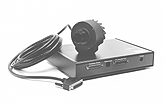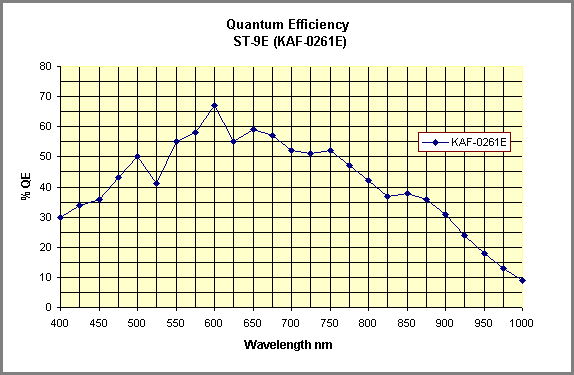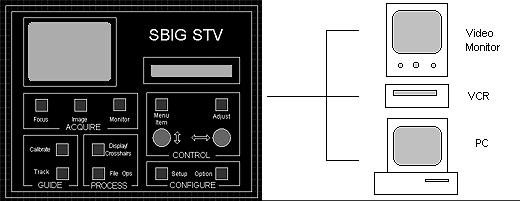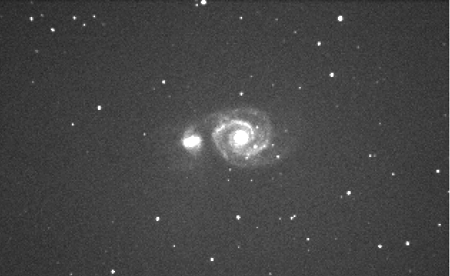 1. ST-237
1. ST-237Announcement
New Products In Development
July 1, 1999
(Updated October 21, 1999)
This announcement is to provide advance information about new products that we expect to release over the next few months. These are products under development and as such we do not have any further technical information, prices or specific release dates to give out other than what is posted in this announcement. When a product matures to the point that we can post more technical data, etc., we will update our web site. As always we appreciate your comments and suggestions for improving our product line.
 1. ST-237
1. ST-237
The ST-237 has been manufactured by SBIG and sold by Celestron as the PixCel 237 for the past two years. Celestron and SBIG have agreed that SBIG will begin to sell the camera directly to the astronomy market. It is an excellent camera with very high quantum efficiency and a reasonable price. The detector is 640 x 480 pixels at 7.4 microns square making it well suited to shorter focal length telescopes and particularly well suited to Celestron's Fastar line of telescopes. The camera has an internal shutter wheel for automatically taking dark frames without the need to cover the telescope. An optional internal color filter wheel that fits inside the 3.5" head is available for automatic tri-color imaging using the supplied CCDOPS software. List price of the ST-237 is $1195. To see more technical data on the ST-237 click here.
Update October 21, 1999: The start of our next production run of the ST-237 cameras has been delayed until December, 1999. As of this update our first three month's production is sold out (through February, 2000) and we are receiving orders every day. Please contact SBIG for the latest delivery schedule if you are interested in this camera.
 2. ST-7E and ST-8E ABG Cameras
2. ST-7E and ST-8E ABG Cameras
Enhanced ABG versions of the ST-7 and ST-8 may be released very soon. We have received engineering samples of the detectors from Kodak and will test them in the ST-7 and ST-8 cameras before officially announcing the ABG versions for sale. We do not expect any problems and if our expectations are met we will start taking orders in July for delivery in September. Prices will be the same as the enhanced non-ABG cameras for both new orders and upgrades. To see more technical information on the ST-7E and ST-8E click here.
Update July 20, 1999: We
have completed testing of the enhanced ABG detectors and and are now taking orders for
ST-7E ABG and ST-8E ABG cameras
 3. The New ST-9E
3. The New ST-9E
The new ST-9E camera is based on an enhanced (Class 1) Kodak KAF-0261E detector. This detector is 512 x 512 pixels @ 20 microns square making it ideally suited for longer focal length instruments (e.g. 100 inches or longer). The KAF-0261E detector utilizes the same new technology to enhance its sensitivity as the detectors used in the new ST-7E and ST-8E cameras. The ST-9E with its much lower dark current promises to compare very favorably with cameras using the similar sized SITe detector for about half the price of these SITe based cameras. For those people who wished we had a self-guided ST-6 this will fill the bill. The KAF-0261E detector is about 80% the size of the KAF-1602E used in the ST-8 although the KAF-0261E has fewer and larger pixels. Physically the camera will look identical to the ST-7 and ST-8. It will have SBIG’s patented self-guiding feature and will accept most optional accessories that are currently made for the ST-7/8 including the CFW8 and AO-7. Kodak's enhanced detector technology will make this a camera that will be hard to beat on larger telescopes.
At this time Kodak only offers the 0261E detector without antiblooming. The ST-9E is a very exciting new product that nicely fills the gap between the ST-7 and ST-8 cameras while offering a new level of performance for larger telescopes. This camera will be approximately 20 times as sensitive as an ST-7 or ST-8 camera equipped with a standard ABG chip.
Update October 21, 1999: We have completed testing the new ST-9E and are now taking orders for the ST-9E. As of this update our production of ST-9E cameras is sold out through the end of December, 1999. The price of the ST-9E is $3950 which includes an enhanced class 1 detector and two stage cooling as a standard features. The cost to upgrade from an ST-7 to an ST-9E is $1800 which includes the new detector, updated electronics and addition of two stage cooling (if your ST-7 is already equipped with two stage cooling the upgrade price is $1500). To see more technical data on the ST-9E click here.
 |
|
Kodak press release regarding the new KAF-0261E image sensor used in the ST-9E camera: |
Improved Blue Plus Image Sensor From KodakROCHESTER, NY, May 14--An improved Blue Plus image sensor has been introduced by Eastman Kodak Company. The Kodak Digital Science™ KAF-0261E image sensor is a high-performance, 512 x 512 resolution front-illuminated full-frame charge coupled device (CCD) with improved blemish specifications, improved packaging to simplify system integration, and improved sensitivity as compared to the KAF-0260 image sensor. The KAF-0261E image sensor is especially suited for astronomy, microscopy, spectroscopy, and medical imaging applications. Features include 512 x 512 resolution with large 20µ x 20µ square pixels, full-frame
architecture, 100% fill factor, and accumulation mode (MPP) operation. The KAF-0261E image
sensor blemish specifications have been improved to eliminate column defects and the
physical packaging is now compatible with the KAF-1600/KAF-0401 image sensor simplifying
integration into cameras supporting the KAF-1600 or KAF-0401 image sensor. The KAF-0261E
image sensor quantum efficiency is 30% at 400 nm, 50% at 550 nm and 60% at 650 nm. Low
dark current, less than 30 pA/cm2 at 25 degrees Centigrade, minimizes the need
for cooling, while focal plane surface flatness of less than 10 microns benefits
applications requiring fiber optic bonding or exacting focal plane tolerance. |
 |
Typical Spectral Response Data updated by Kodak on 6/14/99 |
Click here for more technical information.
4. The New STV
Background: For the past two years we have been quietly developing an entirely new integrating video camera design with video as well as digital output. Our first production version of this new design will be the STV. The camera will use a TC-237 detector and will be unique in the many features it offers. The STV camera will consist of a head and a control box similar to the ST-4 but with many more functions and features. The control box will allow stand alone autoguiding and stand alone imaging! The STV will have on board memory to store a number of images for download at a later time or the user can connect the STV to a computer and download images with the push of a button. The user can also view objects on the optional built in 5" video display. An external video monitor or VCR can be connected to the control box for viewing and recording of the images on video tape.
 |
Autoguider: The STV will
be an extremely sensitive stand alone autoguider (approximately 30 times more sensitive
than an ST-4). Its capabilities will be at least as good as or better than the
autoguiders used in the ST-7 and ST-8 cameras but with a larger field of view. In
binned mode the 237 detector will have 320 x 200 resolution @ 14.8 microns and very high
QE with a field of view almost 2.5 times that of the ST-4. We estimate that when
attached to an 8" f/10 SCT the STV will reach 14th magnitude stars in 1 second.
Exposure rates are adjustable from 0.001 seconds to 600 seconds. With its
higher sensitivity, greater field of view and optional on board video display, finding
guide stars will be easier than with any other autoguider camera currently
available. In addition to the built in video display, the STV will have a large 2
line x 24 character back lit digital display. A menu system will walk the user
through the operation of the STV for autoguiding and for imaging.
 |
Video image of M51 taken
with a prototype STV |
Imager: Unlike the ST-4, the STV will not only be a superior stand alone autoguider, it will also be a superior stand alone integrating video imager. The STV will use the same mechanical head design as our ST-237 CCD camera (but different electronics). This means that it will mate perfectly with all amateur sized telescopes including Celestron's Fastar telescopes. However, the STV will operate in binned mode for full frame images or in unbinned mode when the electronic zoom feature is activated to display the central 320 x 200 area of the detector as a full screen image. Images may be saved in digital format using the on board memory or they may be downloaded to an unattended remote computer by pushing one button on the STV control panel. Images may also be viewed on the optional built-in 5" video display or on any standard TV monitor. Images may also be recorded on video tape for later viewing. The STV will be the most sensitive video imager available to the amateur astronomer.
Update October 21, 1999: Expected delivery date for the first production units is January, 2000. As of this update, our first month's production is sold out.
To see more information on the STV click here:
Digital Integrating Video Camera and Autoguider
 5. The new SGS - Self-Guided Spectrograph
5. The new SGS - Self-Guided Spectrograph
Information about the new spectrograph is already posted
at our web site. The spectrograph utilizes the tracking CCD in the ST-7/8 to
simultaneously view the object to be measured and the spectrograph's slit. Once
placed on the slit, the self-guiding feature of the camera keeps it there for long
exposures. This is normally a very cumbersome task for astronomers making spectroscopic
measurements of dim objects. List price for the spectrograph (not including camera)
is $3950. To see more technical information on the Self-Guided Spectrograph slick here.
 6. Improvements to CCDOPS for Windows 95/98
6. Improvements to CCDOPS for Windows 95/98
Due to high user demand we are making improvements to our camera control software. The next release (by the end of summer) will add Windows NT support and allow exporting images in ASCII, GIF, JPEG and BMP formats. A future release will include the ability to self-guide and auto grab or color grab at the same time and also to import FITS format images. A special feature will allow the user to view the tracking CCD and imaging CCD at the same time. Updates will be posted at our web site as individual features are added. Updates will be free to registered users of CCDOPS for Windows 95/98. List price for all others is $99. To check for the software latest updates click here.
Update August 3, 1999: CCDOPS for Windows 95/98 now supports Windows NT and incorporates the "E" software for cameras with the enhanced detectors. Please check out the latest announcement.
 7. Improvements to CCDOPS for
Macintosh
7. Improvements to CCDOPS for
Macintosh
To check for the software latest updates click here.
We hope that you will be as excited about these new products as we are. The STV in
particular has been a long time in development but it promises to change the way the
beginner views CCD imaging and the way the advanced amateur views video cameras.
While not quite as sensitive as a camera based on the SITe detector, the ST-9E with lower dark current, self-guiding, high sensitivity and large imaging area will nevertheless compete very favorably with other cameras using the 512 x 512 pixel SITe detector at less than half the price of the SITe based cameras.
Please keep in mind that this is an advance notice and the information can and probably will change as we work on these projects. As soon as we have firm release dates and technical specs we will post the information on our web site.
Sincerely,
Michael Barber, VP
SBIG
Revised: October 21, 1999 02:37:56 PM.
Copyright © 1998 Santa Barbara Instrument Group, Inc. All rights reserved.
Please report any problems with this page directly to the Webmaster